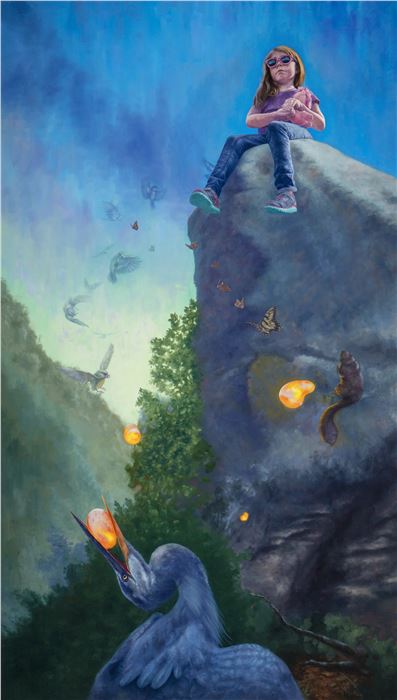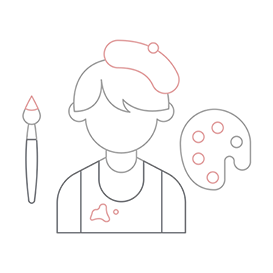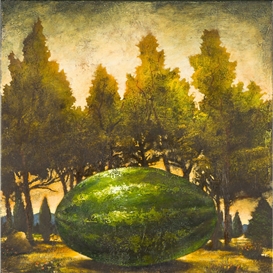Modification, Millennials and the Mutant Beasts
Genetic manipulation and transhumanism inspire a new generation of artists to develop a different way to represent beauty
Michael Pearce / MutualArt
05 Apr, 2024
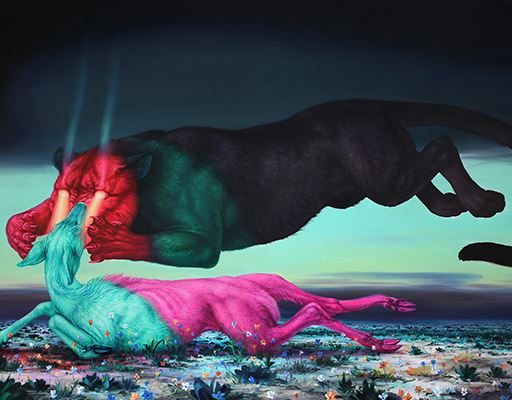
A bubbling and intriguing trend is emerging in the work of the new generation of millennial artists who have managed to launch themselves from the tedium and defense of the tropes of ordinary representation into the realms of imagination. It is in the form of a curious interest in the creative potential of painting mutated animals as the bearers of a new kind of beauty, with novel anatomies and modified morphologies which cannot be found in the taxonomies of ordinary zoology. Their weird is a world where beauty arrives unexpectedly as an outcome of human intervention into mutable nature, and the sentimental sublime of the fantasias of Thoreau and Emerson are tempered by an expectation and nervous acceptance of genetic change. Theirs is a world where ordinary expectations are challenged by the hard realities offered by science in the post-modern era.
The work of Cody Jimenez appears among them, hinting at the uncertainties and fears of his generation with his wonderful creatures bathed in the glow of unnatural light, his piece Wonder, 2017, beginning his instinctive exploration of the uncanny balance between the innocence of childhood and the unstable future of flexible species, and the compulsive egret of his more recent Strength, 2020, gulping a luminous and pulsating blob of incandescence as it emerges from the fog of uncertainty under the eye of a watchful child, balanced with the confidence of youth on the edge of the precipice. But Jimenez’ creatures are psychological allegories playing a role as guardians protecting us from the anxieties of alienation, and are at a distance from the heart of the issues of genetic innovation.
Cody Jimenez, Strength, 2020
The caprice and threat of nuclear war that loomed over the twentieth century spawned Godzilla and a cast of terrifying aliens and predators which haunted our imaginations. But in 1986, the Chernobyl exclusion zone failed to breed promised monsters, and when the reactors of Fukushima exploded in the apocalypse of earthquake and tsunami in 2011, nary as much as an exciting squid emerged from the ocean flapping engorged tentacles to satisfy our amplified expectations of a new leviathan. The new, understated creatures of millennial painters are softer than their monstrous predecessors – they are further down the food chain, with subtler slime and tooth than the apex predators of peak horror. Kevin Sloan’s paintings hint at the problem, disturbing and comedic in equal measure, with herons and doves decorated in the stencil of Chinese blue and white ceramics, and a tattooed elephant balanced upon a stack of china teacups, but his priority is the ticking clock that times environmental disaster.

In 1896, H.G. Wells’ Island of Doctor Moreau explored ground intersecting the problems of genetic manipulation during the early years of science fiction, but his impossibly vivisected Beast Folk lacked either the dystopic conviction or the genetic accuracy of brilliant Aldous Huxley’s Brave New World, which predicted the outcome of accepting the creeping compromises of DNA modification with frightening accuracy.
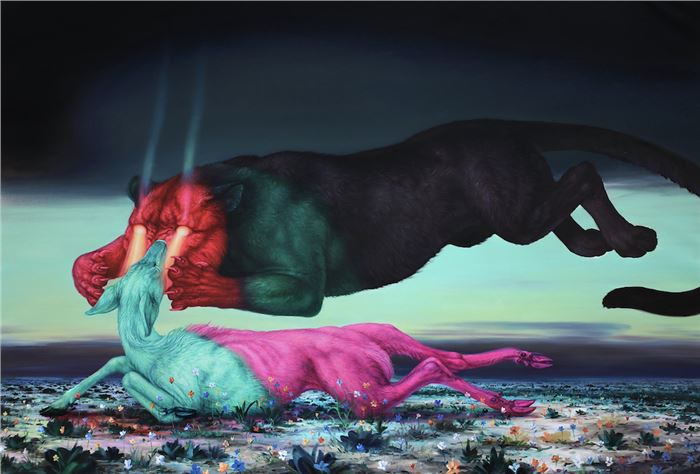
The birth of Dolly, the cloned sheep, in 1996 revealed the true potential of practical genetics and opened the gateway to new mutant beasts, and transhumanist writers began questioning the limits of human bodies, raising challenging ethical questions about the rights of individuals to change themselves, to modify their bodies by any means – genetics, and robotics became increasingly available, and the potential for aesthetic transformations was within reach. Steroidal bodybuilders shaped previously impossible musculature; with implants and alterations, plastic surgeons turned people into humanoid cats and snakes; engineers built mechanical extensions to recreate the actions of surgically removed limbs – why not go a step beyond, and make the prosthetics superior to the human limbs they replaced? Gen-X body-modders of the 1990s split their tongues, implanted horns into their skulls, and shaped their faces with plastic surgery, treating themselves as works of art, but the aesthetic implications of generational genetic manipulation became clear in the shocking moment in millennial 2013 when scientists from universities in Turkey and Hawaii succeeded in using jellyfish DNA to alter rabbit embryos. As they matured into adult bunnies, they glowed the green radiance of bioluminescence in the darkness. The same experiment succeeded with cockroaches and cats, and suddenly the gene pool had the imaginative potential of a radioactive playground. Angela Gram responded with a spectacular series of mutant beasts, including her Night Vision, 2023, an oil painting of a monstrous and muscled feline with fur hued in ivory black, blood red and sap green, led by the incandescence and hypnotism of its bright-eyed spot-lit beams to a killing leap upon the neck of its tumbled prey, a buckled pink and aquamarine deer, abandoned to its fate. These are paintings of the zeitgeist: she is a prophet of the gene-pool palette.
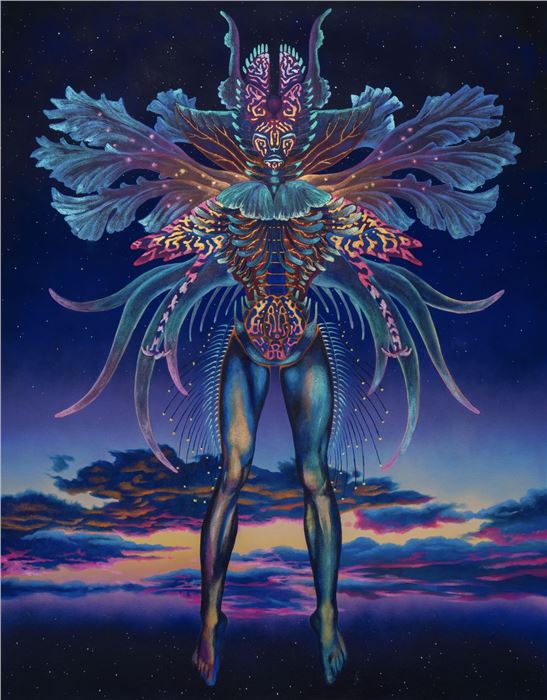
Freyja Dean, Animal Bridegroom, 2022
Recent controversies over gender fluidity reflect the fear and ethical confusion which travels arm-in-arm with transhumanism. Multiple issues emerge: Do individuals have sovereign rights over their own bodies? Are hubristic humans intruding upon the creative domain previously reserved to gods? Where does the borderline lie that separates benevolent interventions from willful interference and harm to others? These are among the big questions of our age – now our children can be our works of art. Freyja Dean is one of the few artists to explore the potential of fully realized transhumanism, working on her cleverly named iDollatry drawings, paintings, and 3D printed sculptures to imagine how human bodies might be adapted using DNA to transform into new beings.
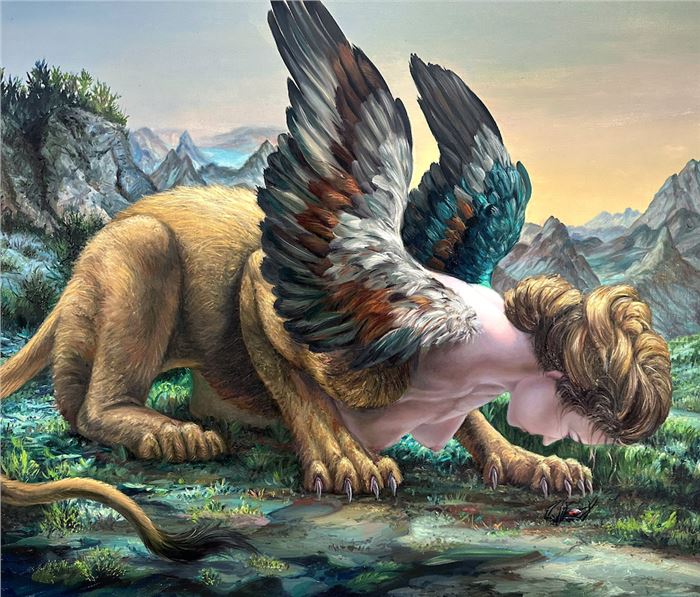
Recognizing the creeping compromises of DNA manipulation without collapsing into the preternatural perversity of murderous Ted Kaczynski, some artists respond to the present by reaching back into the distant past, seeking a time when the distressing uncertainties of the future were unimaginably distant. Gram looked to the Sphinx of Ancient Egypt to find connection to the anthropomorphs of the classical world, reimagining the enigmatic riddler of the Oedipean myth as a creature in the blends and blushes of skilled representational technique, to give life to the frozen forms of familiar monumental sculptures. The sphinx asked heroic Oedipus what walked on four feet in the morning, two feet at noon, and three feet by evening. Oedipus answered that this was man, crawling as a baby, walking as an adult, and leaning on a stick in age. But Gram’s sphinx examines a crumpled black widow spider – the glossy emblem of death is dead, while new hybrid life endures. The painting seems to imply that though genetic manipulation may close the door on aging, and perhaps open a new utopian era, humans must become unhuman to enjoy the benefits of mythic immortality.

If Gram’s allegory is too alarming, there is comfortable appeal in Tach Pollard’s simple wood carvings of the pagan deities and animal spirits of a prehistoric proto-Celtic myth, where a similar parallel emerges – in his comfortable sculptures chthonic divinities and shamans take on hybrid forms: part animal, part creature, echoing the potential of genetic manipulation to shapeshift between the strata of the radiant forms. These are days of mythic wonders when such creations are within our grasp. The circle completes, and half-beast, half man, we become the ancient gods.
For more on auctions, exhibitions, and current trends, visit our Magazine Page

 ARTISTS
ARTISTS







